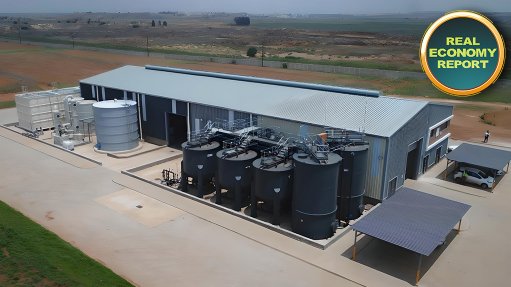EVs – grid assets in the making
This article has been supplied by the author and has not been written or solicited by Creamer Media. It may be available only for a limited time on this website.
By Dwibin Thomas, Cluster Automation Leader at Schneider Electric
Electric Vehicles (EVs) have become somewhat commonplace in numerous countries. With its own, bona fide racing events such as Formula E and Extreme E, it’s safe to say the green technology has cemented its role in the automotive industry.
In South Africa, the EV market is enjoying some encouraging awareness, however, lack of supporting infrastructure such as charging stations and ongoing power outages remain dealbreakers for some.
Interestingly, EVs have the potential to address some of our country's power supply problems. These vehicles have the ability to store a significant amount of power in its batteries, typically ranging from 40 to 100 kilowatt-hours, depending on the car's size and make.
This is significant, particularly when you consider that cars are parked for our hours on end, with their batteries fully charged and simply standing still. It is during this time when these batteries can give back to the grid. Just imagine thousands of parked cars providing much-needed power to grid.
Furthermore, many of these vehicles are parked close to buildings and homes, where a significant portion of power is needed. This proximity reduces energy losses during transmission, which is often the case when power is transported over long distances.
EV power in action
So how would this work? For one, your EV will have to be connected to smart charger – these units are not standalone but integrated into buildings and homes and connected to the power outlet to assist with charging.
These smart chargers can communicate with a utility which then allows for remote monitoring of these devices. Through this remote monitoring, a utility can then draw additional power from these parked vehicles and feed it back into the grid.
Smart charging stations also provide layers of intelligence such distributed energy resource management systems (DERs) which provide grid with the ability to monitor various energy resources such as EVs.
EV’s and other sources of DERMscan then be processed by Virtual Power Plants (VVPs) which will then aggregate and dispatch energy as well as support demand response requirements. A VPP platform can treat multiple EVs as a single energy source, dynamically managing their discharging and power supply into the grid.
With the right technology and infrastructure, EVs can become an intelligent part of the grid, dynamically adjusting and balancing the energy supply. Importantly, it can feed excess power back into the grid, when needed. This level of integration and intelligence can significantly contribute to the stability and efficiency of an energy system.
There’s no doubt that EVs have the potential to be much more than just standalone vehicles; it can become smart grid assets, actively participating in demand management whilst helping to address energy supply challenges.
Schneider Electric’s AutoGrid Flex is a powerful solution that can greatly assist with the integration of EVs. By leveraging advanced analytics and machine learning algorithms, AutoGrid Flex enables efficient management of EV charging, optimising energy usage, and minimizing costs.
With its intelligent demand response capabilities, it can coordinate EV charging schedules to avoid peak demand periods, ensuring grid stability. AutoGrid Flex also empowers utilities to offer innovative pricing programs, incentivising EV owners to charge during off-peak hours, thereby reducing strain on the grid and maximizing renewable energy utilisation.
Comments
Press Office
Announcements
What's On
Subscribe to improve your user experience...
Option 1 (equivalent of R125 a month):
Receive a weekly copy of Creamer Media's Engineering News & Mining Weekly magazine
(print copy for those in South Africa and e-magazine for those outside of South Africa)
Receive daily email newsletters
Access to full search results
Access archive of magazine back copies
Access to Projects in Progress
Access to ONE Research Report of your choice in PDF format
Option 2 (equivalent of R375 a month):
All benefits from Option 1
PLUS
Access to Creamer Media's Research Channel Africa for ALL Research Reports, in PDF format, on various industrial and mining sectors
including Electricity; Water; Energy Transition; Hydrogen; Roads, Rail and Ports; Coal; Gold; Platinum; Battery Metals; etc.
Already a subscriber?
Forgotten your password?
Receive weekly copy of Creamer Media's Engineering News & Mining Weekly magazine (print copy for those in South Africa and e-magazine for those outside of South Africa)
➕
Recieve daily email newsletters
➕
Access to full search results
➕
Access archive of magazine back copies
➕
Access to Projects in Progress
➕
Access to ONE Research Report of your choice in PDF format
RESEARCH CHANNEL AFRICA
R4500 (equivalent of R375 a month)
SUBSCRIBEAll benefits from Option 1
➕
Access to Creamer Media's Research Channel Africa for ALL Research Reports on various industrial and mining sectors, in PDF format, including on:
Electricity
➕
Water
➕
Energy Transition
➕
Hydrogen
➕
Roads, Rail and Ports
➕
Coal
➕
Gold
➕
Platinum
➕
Battery Metals
➕
etc.
Receive all benefits from Option 1 or Option 2 delivered to numerous people at your company
➕
Multiple User names and Passwords for simultaneous log-ins
➕
Intranet integration access to all in your organisation





















